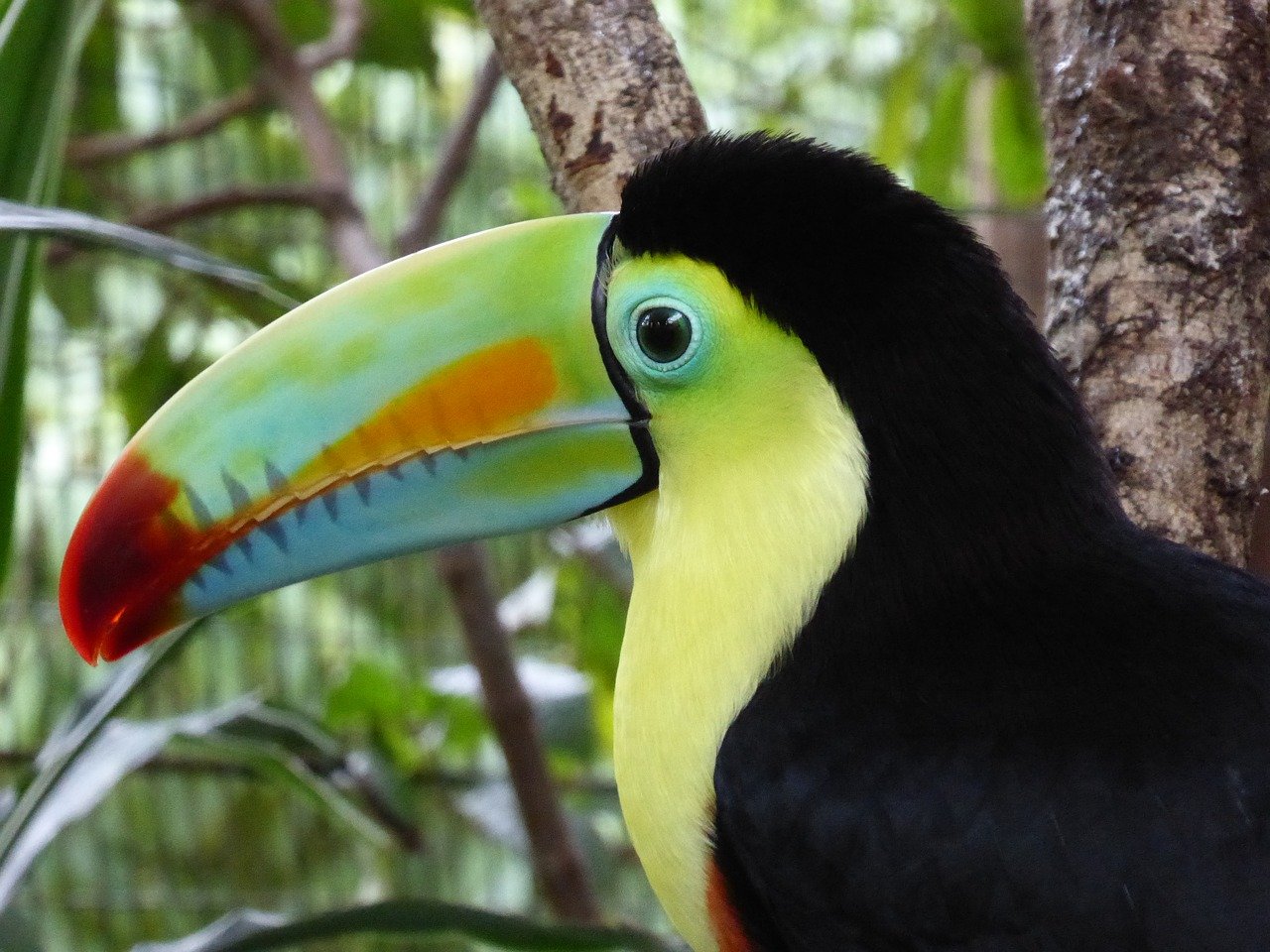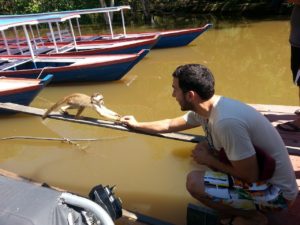¿Tienes mascotas? Do you have any pets?
People keep all sorts of animals as pets, but the most common ones are un perro / una perra a dog, un gato / una gata a cat, un pez dorado a goldfish, un perico / un periquito a parakeet, un loro a parrot, un hámster a hamster. Two animals that aren’t usually pets but that you can often find in or around buildings are: un ratón a mouse, una rata a rat.
- Tenemos un perro y un gato.
We have a dog and a cat. - ¿Cómo se llama tu perro/gato?
What’s your dog’s/cat’s name? - Estoy jugando con nuestro perrito.
I’m playing with our puppy.
- Estoy acariciando a nuestro gatito.
I’m petting our kitten. - ¿Tu perro muerde?
Does your dog bite? - ¿Tu gato araña?
Does your cat scratch? - Tengo un pez dorado en una pecera.
I have a goldfish in a fishbowl. - Tengo muchos peces en un acuario.
I have a lot of fish in an aquarium. - Tenemos dos hámsteres en una jaula.
We have two hamsters in a cage. - Mi loro habla mucho.
My parrot talks a lot. - Grité cuando vi un ratón.
I screamed when I saw a mouse. - Eso no es un ratón, es una rata.
That’s not a mouse, it’s a rat.
¿Qué sonido hace un perro? What sound does a dog make?
In English, dogs say “woof” and cats say “meow,” but of course that’s all different in Spanish.
- Los perros ladran. El perro hace “¡Guau!”
Dogs bark. A dog says “Woof!” - Los gatos maúllan. El gato hace “¡Miau!”
Cats meow. A cat says “Meow!” - Los pájaros pían. El pájaro hace “Pío, pío.”
Birds chirp. A bird says “Tweet.” - Las vacas mugen. La vaca hace “¡Mu!”
Cows moo. A cow says “moo.” - Los gallos cacarean. El gallo hace “¡Quiquiriquí!”
Roosters crow. A rooster says “cock-a-doodle-do.” - Los patos parpan. El pato hace “¡Cua, cua, cua!”
Ducks quack. A duck says “quack.” - Los cerdos gruñen. El cerdo hace “¡Oinc, oinc!”
Pigs squeal. A pig says “oink oink.” - Los perros gruñen cuando están enojados.
Dogs growl when they’re angry. - Los gatos ronronean cuando están contentos.
Cats purr when they’re happy.
En la granja: On the Farm
The most usual animals on a farm are: un caballo / una yegua a horse, una vaca a cow, un toro a bull, un cerdo, un puerco a pig, una oveja a sheep, un pollo a chicken, un ganso a goose, una cabra a goat, un asno / un burro a donkey.
- El caballo corre en el prado.
The horse is running in the pasture. - Las vacas están en el establo.
The cows are in the barn. - Los cerdos se acuestan en el barro/fango.
The pigs are lying in the mud. - Los pollos están en el gallinero.
The chickens are in the coop. - El granjero ordeña las vacas.
The farmer milks the cows. - Las gallinas ponen huevos.
Hens lay eggs. - La lana viene de las ovejas.
Wool comes from sheep.
Some other words related to animals that you want to know are: el pelaje fur, las escamas scales, una cola, un rabo a tail, un casco, una pezuña a hoof, un cuerno, un cacho a horn, una pluma a feather, una crin a mane, una garra a claw.
- El caballo tiene una hermosa crin.
The horse has a beautiful mane. - El ganso tiene tiene plumas blancas.
The goose has white feathers. - Los toros tienen cuernos/cachos.
Bulls have horns. - El cerdo tiene una colita.
The pig has a little tail. - ¿Qué animales tienen cascos/pezuñas?
Which animals have hooves? - ¡Ten cuidado! El gato tiene garras afiladas.
Be careful! The cat has sharp claws.
Pájaros / Aves: Birds
Here’s some vocabulary for our feathered friends: un pájaro / un ave (f.) a bird, un pato a duck, un tucán a toucan, un águila (f.) an eagle, un halcón a hawk, una paloma a pigeon, un pavo a turkey, un pavo real a peacock, un cisne a swan, un búho, una lechuza an owl, una gaviota a seagull.
- ¿Oyes a los pájaros?
Do you hear the birds? - Hay algunos patos al lado del lago.
There are some ducks next to the lake. - Las águilas vuelan muy alto.
Eagles fly very high. - Los pavos reales tienen plumas hermosas.
Peacocks have beautiful feathers. - Hay muchas palomas en el parque.
There are a lot of pigeons in the park. - Los cisnes son animales muy elegantes.
Swans are very elegant animals. - Un búho ulula en el bosque.
An owl is hooting in the woods. - Las gaviotas vuelan sobre la playa.
The seagulls are flying over the beach.
Animales salvajes: Wild Animals
The most common wild animals around the world are these: un ciervo, un venado a deer, un oso a bear, un lobo a wolf, un jaguar / yaguar a jaguar, un zorro a fox, un coyote a coyote, un mapache a raccoon, un perezoso a sloth, una ardilla a squirrel, un conejo a rabbit, un murciélago a bat, una serpiente, una culebra a snake, un lagarto a lizard.
- Los ciervos/venados comen hierva en el campo.
The deer are eating grass in the field. - Un zorro corrió hacia el bosque.
A fox ran into the woods. - Vimos un oso cuando estábamos de excursión.
We saw a bear when we were hiking. - Los lobos aúllan en la noche.
Wolves howl at night. - Las ardillas trepan a los árboles muy rápido.
Squirrels climb trees very quickly. - ¿Hay mapaches aquí?
Are there raccoons here? - Los murciélagos salen después del atardecer.
Bats come out after sunset. - ¡Ten cuidado! Hay una serpiente en el camino.
Be careful! There’s a snake on the path.
En el zoológico: At the Zoo
Depending on where you live, you may not need to go to a zoo to see these animals. But for most of us, a zoo is the only place where we’ll see these: un elefante an elephant, un león a lion, un tigre a tiger, una jirafa a giraffe, una cebra a zebra, un rinoceronte a rhinoceros, un mono a monkey, un gorila a gorilla, un hipopótamo a hippopotamus.
- Los elefantes tienen trompa y colmillos largos.
Elephants have trunks and long tusks. - Los leones y rugen y gruñen.
Lions roar and snarl. - Los tigres tienen rayas.
Tigers have stripes. - Las jirafas tienen cuellos muy largos.
Giraffes have very long necks. - Las cebras tienen rayas negras y blancas.
Zebras have black and white stripes. - Los rinocerontes tienen un cuerno muy largo.
Rhinos have very big horns. - Los monos pasan mucho tiempo en los árboles.
Monkeys spend a lot of time in trees. - Los gorilas son muy parecidos a las personas.
Gorillas are very similar to people. - Los hipopótamos corren muy rápido.
Hippos run very fast.
En el agua: In the Water
If you live near a lake or river, you may see some of these: un pez a fish, una rana a frog, una tortuga a turtle, un castor a beaver, un caracol a snail, un caimán an alligator, un cocodrilo a crocodile.
- ¿Qué tipo de peces habitan en este lago?
What kind of fish live in this lake? - Hay una tortuga en esa roca/piedra.
There’s a turtle on that rock. - Por la noche oímos ranas durante el verano.
We hear frogs at night in the summer. - Los caracoles se mueven muy, muy lento.
Snails move very, very slowly. - Los castores muerden los árboles y hacen diques.
Beavers chew trees and make dams. - ¿Eso es un caimán o un cocodrilo?
Is that an alligator or a crocodile?
In the ocean, you may see: un tiburón a shark, una ballena a whale, un delfín a dolphin, un cangrejo a crab, una langosta a lobster, una medusa / un aguamala (f.) a jellyfish, una estrella de mar a starfish, un erizo de mar a sea urchin, una anguila an eel, una almeja a clam, un mejillón a mussel, un camarón / una gamba a shrimp, un pulpo an octopus, un calamar a squid.
- Me dan miedo los tiburones, por eso no nado en el mar.
I’m afraid of sharks, so I don’t swim in the ocean! - Vimos delfines nadando cerca de la playa.
We saw dolphins swimming near the beach. - Hoy no vamos a nadar. Hay demasiadas medusas / aguamalas.
We’re not swimming today. There are too many jellyfish. - Encontramos una estrella de mar en la playa.
We found a starfish on the beach. - ¡Ay! Pisé un erizo de mar. ¡Es muy doloroso!
Ouch! I stepped on a sea urchin. That’s painful! - Hay muchos cangrejos cerca de esas rocas.
There are a lot of crabs near those rocks. - Las almejas viven en la arena.
Clams live in the sand. - Los mejillones viven en las rocas.
Mussels live on rocks.
Insectos y otras criaturas pequeñas: Insects and Other Small Creatures
If you every need to talk about insects, bugs, or other creep-crawlies, you will need to know these: un bicho / un insecto a bug, una araña a spider, una abeja a bee, un escarabajo a beetle, una hormiga an ant, una mariquita a ladybug, una mosca a fly, un mosquito / un zancudo a mosquito, una mariposa a butterfly, una polilla a moth, un gusano / una lombriz a worm, un escorpión a scorpion.
- Odio los insectos.
I hate bugs! - Hay una araña grande andando en la pared de mi habitación / cuarto.
There’s a big spider crawling on the wall in my bedroom! - Los mosquitos/zancudos están picando esta noche.
The mosquitos are biting me tonight. - ¡Me picó una abeja!
I was stung by a bee! - Las mariposas son hermosas y coloridas.
Butterflies are beautiful and colorful. - Las polillas vuelan alrededor de las luces en la noche.
Moths fly around lights at night. - Los gusanos viven en la tierra.
Worms live in the soil. - Las mariquitas son negras y rojas.
Ladybugs are black and red. - ¡Ten cuidado! Hay escorpiones aquí.
Be careful! There are scorpions here.
Learn Spanish with the Language Garage!
Interested in more Spanish? Check out our other posts on Spanish language, culture, and more. If you’re looking for convenient and affordable live Spanish lessons with a real teacher, visit The Language Garage. Our lessons are affordable and fun, and they’re given online in a virtual classroom, so it doesn’t matter where you live or work – we can come to you. We have flexible options, with a free trial so that you can decide if there’s a fit. Check us out!
Free Student Book and Audio
You can access our original student book and practice audio here. If you’d like to use it with an instructor, you can enroll in lessons. Or you can use it on your own as self-study, totally free.
Image by MillerGruppe from Pixabay




